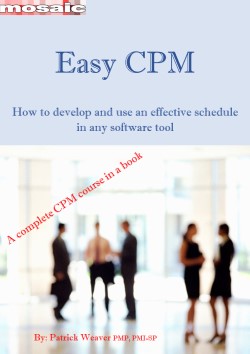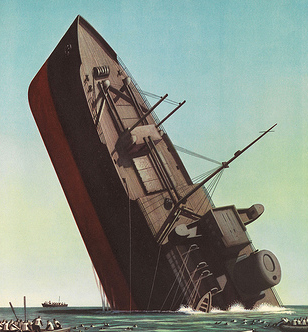Location:
PMKI > Project
Controls and Scheduling > Schedule Development
& Time Analysis.


- Building a dynamic CPM schedule
- Duration
Estimating
- CPM time analysis calculations
- The critical path and float
- Float
- Useful External Web-links &
Resources.
Other related sections of the PMKI:
- Resource & Costs
Analysis
- Reporting &
Communicating Controls Information
 Designing
a schedule for a complex project is an art, first the
project needs to be planned (WP1039 focuses on planning), and
then the project controls system needs to be designed, the
before an effective, dynamic, schedule can be developed.
The development of CPM in the 1950s was constrained by the
limited processing power of the computers then available,
unfortunately, these limitations still have significant
impacts on the CPM modelling process we still use today.
For more on the development of CPM schedules see:
Designing
a schedule for a complex project is an art, first the
project needs to be planned (WP1039 focuses on planning), and
then the project controls system needs to be designed, the
before an effective, dynamic, schedule can be developed.
The development of CPM in the 1950s was constrained by the
limited processing power of the computers then available,
unfortunately, these limitations still have significant
impacts on the CPM modelling process we still use today.
For more on the development of CPM schedules see:
The Origins of CPM, PDM and PERT Schedules.
DP: Dynamic Scheduling describes the benefits derived from developing a 'good schedule' as defined in a 'A Guide to Scheduling Good Practice'. Open the paper.
DP: A Guide to Scheduling Good Practice describes the work undertaken by a scheduler to create an effective 'dynamic schedule' and is consistent with the PMBOK® Guide and the PMI Practice Standard for Scheduling. Open the paper.
WP: Rolling Wave Planning. Rolling wave is a form of progressive elaboration, increasing the detail in a schedule as more information becomes available.
WP: Schedule Density. The concept of schedule density is similar to rolling wave planning but applies a time based three stage approach to developing an overall summary, 12 month intermediate, and 3 month detailed schedule.
DP: Links, Lags & Ladders focuses on the issues, problems and challenges of overlapping tasks in a schedule using various link types (F-S, S-S, F-F-, S-F) with or without lead and lag durations, the more sophisticated 'ladder' concept, and the importance of actively managing the 'space' between tasks. Open the paper.
Art: Hammocks, LOE and Summary Activities in Schedules. Hammocks, LOE and Summary Activities are three completely different types of activity – the differences are defined.
Blg: CPM Scheduling – the logical way to error #1. Logical anomalies in a CPM schedule can cause unexpected consequences when an activity duration is changed - for example, increasing the duration of a critical activity reduces the overall project duration. This post highlights the issue.
Blg: CPM Scheduling – the logical way to error #2. More logical anomalies in a CPM schedule that can cause unexpected consequences when an activity duration is changed.
The information in these papers (and more) has been consolidated into an easy-to-read book Easy CPM.
 Easy CPM is
a course-in-a-book that provides practical training and
guidance to individuals and organizations involved in
developing or using CPM schedules based on the Critical
Path Method (CPM). It is designed to act as both a
reference, and practice guide, for people implementing CPM
scheduling after they have learned to use the CPM
scheduling software of their choice.
Easy CPM is
a course-in-a-book that provides practical training and
guidance to individuals and organizations involved in
developing or using CPM schedules based on the Critical
Path Method (CPM). It is designed to act as both a
reference, and practice guide, for people implementing CPM
scheduling after they have learned to use the CPM
scheduling software of their choice.
See more, free preview and buy ($35, immediate download).
Duration Estimating
 Probably the most common
action undertaken by planners everywhere is assigning a
duration to a task; most of us do this almost
automatically. Generally it is only when a dispute arises
the complex interaction of the factors discussed in this
sub-section come into play. The purpose of this section is
not to reach any conclusion on what is the ‘correct’
way to assess durations (we suggest there is no
universally correct answer this question), rather to put
into one place the multiple factors that should be
considered by competent planners and managers. The initial
planning decisions concern the project framework used to
define the task:
Probably the most common
action undertaken by planners everywhere is assigning a
duration to a task; most of us do this almost
automatically. Generally it is only when a dispute arises
the complex interaction of the factors discussed in this
sub-section come into play. The purpose of this section is
not to reach any conclusion on what is the ‘correct’
way to assess durations (we suggest there is no
universally correct answer this question), rather to put
into one place the multiple factors that should be
considered by competent planners and managers. The initial
planning decisions concern the project framework used to
define the task:
Once the task is determined, and the overall project framework set; the issues concerning the estimation of the optimum task duration come into play:
Once the task durations have been determined, the next factor to consider is the overall scheduling process; balancing schedule logic, working times, tasks durations and resources to achieve the overall project objectives, whilst allowing appropriate contingency times for risks. This process frequently requires adjustments to the pre-determined optimum duration for a task to achieve contractual objectives, balance resources, and/or meet imposed constraints.
WP: Duration Estimating. The challenge of assigning an accurate duration to a task. This paper describes the processes involved in duration estimating. The important effect of cognitive biases on the way estimates are developed is discussed in WP1069.
PP: (The) Cost of Time - or who's duration is it anyway? Probably the most common action undertaken by schedulers everywhere is assigning a duration to a task. This paper outlines the factors influencing the choice of an optimum duration. Considers the factors that can cause the duration to be modified during the planning phase and then outlines some of the likely costs associated with accelerating the project. Download the paper.
Prs: Estimating Fallacies - excessive detail does not help. Estimating costs and durations can be done in great detail, however, detailed is not synonymous with accurate! This paper sets out a pragmatic framework for estimating that offers realistic levels of accuracy to generate sensible expectations for a reasonable investment of estimating effort. Download the presentation.
WP: Schedule Compression. This WP focuses on the techniques and risks associated with schedule compression, including 'fast-tracking' and 'crashing'.
DP: Schedule Calculations a guide the Time Analysis and Float calculations used in PDM schedules. Open the paper.
Blg: Schedule Calculations – Old and New. The difference between old manual calculations starting from Zero, and the correct calculations used by modern computers.
Blg: Critical Path Characteristics and Definitions. This post asks the question why people continue to use incorrectly use 'float' to define the critical path 40 years the basis of the definition was invalidated by advances in scheduling software. The second part of this post looks at the problem of Gen AI systems referencing, and then re-referencing, incorrect information creating a false framework for people.
The mathematical precision of critical path scheduling also caught the attention of lawyers and contract draftsmen leading to the evolving concept of the ‘contract program’ and conferring a degree of legal certainty onto the schedule that cannot be supported by objective analysis. This topic analyses the factors creating the ‘critical path’ and ‘float’ within a schedule and then look at ways of resolving the conflicting views around the critical path and float.
WP: Defining the Critical Path. There are many different descriptions in regular use, this WP provides a concise and accurate definition.
Art: Calendars and the Critical Path - This article demonstrates how using multiple calendars can cause different float values to appear in the same sequence of activities (or may not). This can be particularly confusing for activities on the critical path.
Art: Negative Float and the Critical Path - Negative float is always caused by imposed dates (constraints), which can be very useful in identifying the degree of challenge faced by a project in meeting its contractual, or other obligations, represented by the constrained date placed on an activity or milestone. This article shows how negative float is created.
Blg : Critical confusion – when activities on the critical path don’t compute…… The use of Finish-to-Finish and Start-to-Start links (particularly in combination) can cause significant issues in calculating the overall project duration.
Blg: CPM Scheduling – the logical way to error #1. Logical anomalies in a CPM schedule can cause unexpected consequences when an activity duration is changed - for example, increasing the duration of a critical activity reduces the overall project duration. This post highlights the issue.
Blg: CPM Scheduling – the logical way to error #2. More logical anomalies in a CPM schedule that can cause unexpected consequences when an activity duration is changed.
 The
concept of schedule ‘float’ was created in 1957. The
existence of a ‘critical path’ and non-critical activities
(with their associated ‘float’) grew out of the science of
‘scheduling’ as defined by Critical Path Analysis (CPA).
In 1956/57 Kelley and Walker started developing the
algorithms that became the ‘Activity-on-Arrow’ or ADM
methodology and from the 1960s onward, the use of
‘critical path’ techniques began to dominate project
scheduling; see:
The
concept of schedule ‘float’ was created in 1957. The
existence of a ‘critical path’ and non-critical activities
(with their associated ‘float’) grew out of the science of
‘scheduling’ as defined by Critical Path Analysis (CPA).
In 1956/57 Kelley and Walker started developing the
algorithms that became the ‘Activity-on-Arrow’ or ADM
methodology and from the 1960s onward, the use of
‘critical path’ techniques began to dominate project
scheduling; see:
A
Brief History of Scheduling - Back to the Future.
During the 60s and 70s significant advances in the concept of float occurred as the ADM scheduling methodology developed. Much of this sophistication has been lost in the intervening 50 years as the PDM methodology gained precedence. How significant is this loss of insight? From a practical perspective there are two issues of paramount importance:
1. Resources leveling and smoothing is completely reliant on having access to accurate and understandable float values. The absence of these means the scheduling algorithms are likely to be less efficient.
2. Contract management relies on clearly defining critical and non-critical activities and knowing how much flexibility (float) is reasonably available on the non-critical activities.
This topic argues that the lack of defined calculations
for most of the float values in a PDM schedule must reduce
the overall value of the schedule model compared to more
rigorous approaches. But also recognizes that if
scheduling is a modelling process designed to affect the
future behaviors of people working on the project (ie,
persuade them to work to the plan), other factors may be
more important.
DP: Schedule Float discusses the various calculations and definitions for float in both ADM and PDM networks. Open the paper.
Art: Calculating and Using Float. Based on the above, this review looks at the different types of float and slack that used to be calculated in ADM and PDM schedules, compared to the limited options used today (see the original PM World Today article).
PP: Float - Is It Real? The existence of a ‘critical path’ and non-critical activities (with their associated ‘float’) grew out of the science of ‘scheduling’ as defined by Critical Path Analysis (CPA) and are barely 50 years old! This paper analyses the factors creating the ‘critical path’ and ‘float’ within a schedule and then look at ways of resolving the conflicting views of float encountered in the literature. Potential solutions include the UK ‘Delay and Disruption Protocol’, client led integrated teams and the use of alternative planning methods such as location based scheduling, trend analysis and earned schedule. Download the paper.
Art: Float is it real? Float only exists because of the limitations built into CPM calculations, while it is useful, it is not 'real' - short summary.
Access the Guild of Project Controls Body of Knowledge. A suite of process-based documents which define Project Controls (membership required): http://www.planningplanet.com/guild/GPCCAR-modules